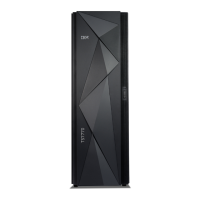August 15, 2017
© Copyright IBM Corporation, 2017 Page 19 of 117
The steps used to define volser range(s) can be found in Appendix A – Volser Range Definition for
systems running 8.30.x.x or higher code, Appendix B – Volser Range Definition for systems from
8.5.x.x to 8.21.x.x and Appendix C – Volser Range Definition for pre 8.5.x.x systems.
Note: For the physical volumes that you use for copy export, defining a specific volser range to be
associated with a secondary pool on a source TS7700 may simplify the task of knowing the volumes to
use in recovery and in returning a volume that no longer has active data on it to the TS7700 that
manages it
Note: When a volser range changes, the media types and storage pools for existing volumes in the
library do not change. Volumes inserted subsequently reflect the new set of ranges and associated
media types and storage pools. A volser range cannot conflict with existing volsers of a different media
type.
4. Define the characteristics of the physical volume pools used for Copy export to the library by following
the procedures found in Appendix A – Manage Physical Volume Pool Properties for systems running
8.30.x.x or higher code, Appendix B – Manage Physical Volume Pool Properties for systems from
8.5.x.x to 8.21.x.x and Appendix C – Manage Storage Pool Properties for pre 8.5.x.x systems.
If the customer has E07 or E08 drives installed, then from the Management Interface, a customer would
have a new option in Pool Properties that will allow them to select a desired recording format for an
Export Pool. This field is called Copy Export Recording Format, and can only be assigned to a pool that
is defined as an Export Pool. The Copy Export Recording Format should be set previous to having any
data written to the pool to ensure that all the physical tapes within the pool are of the desired recording
format. Once the Copy Export Recording Format is set to a desired recording format, then the physical
tapes that are written from that point on will be of the specified recording format. Since the recording
format was established at the beginning of the use of pool, the tapes exported will have the desired Copy
Export Recording Format. Copy Export Recording Format should be set as the format readable at the
recovery site.
The following values are valid as Copy Export Recording Format. Selectable value depends on which
drive types are in the library:
Default The highest common format supported across all drives in the library. This the default value.
E06 Format of 3592-E07 Tape Drive
E07 Format of 3592-E07 Tape Drive
E08 Format of 3592-E08 Tape Drive
5. Code/modify the management class Automatic Class Selection (ACS) routine
Add selection logic to the management class Automatic Class Selection (ACS) routine to assign the new
Management Class name(s) as appropriate. For example, if all jobs with the high level qualifier
BACKUP_DATA are to be written to a TS7700 and be taken offsite with copy export, then a portion of
the ACS filter routine would include:
WHEN &HLQ EQ ‘BACKUP_DATA’
DO
SET &MCLASS = ‘MCPRIATL’
EXIT
END

